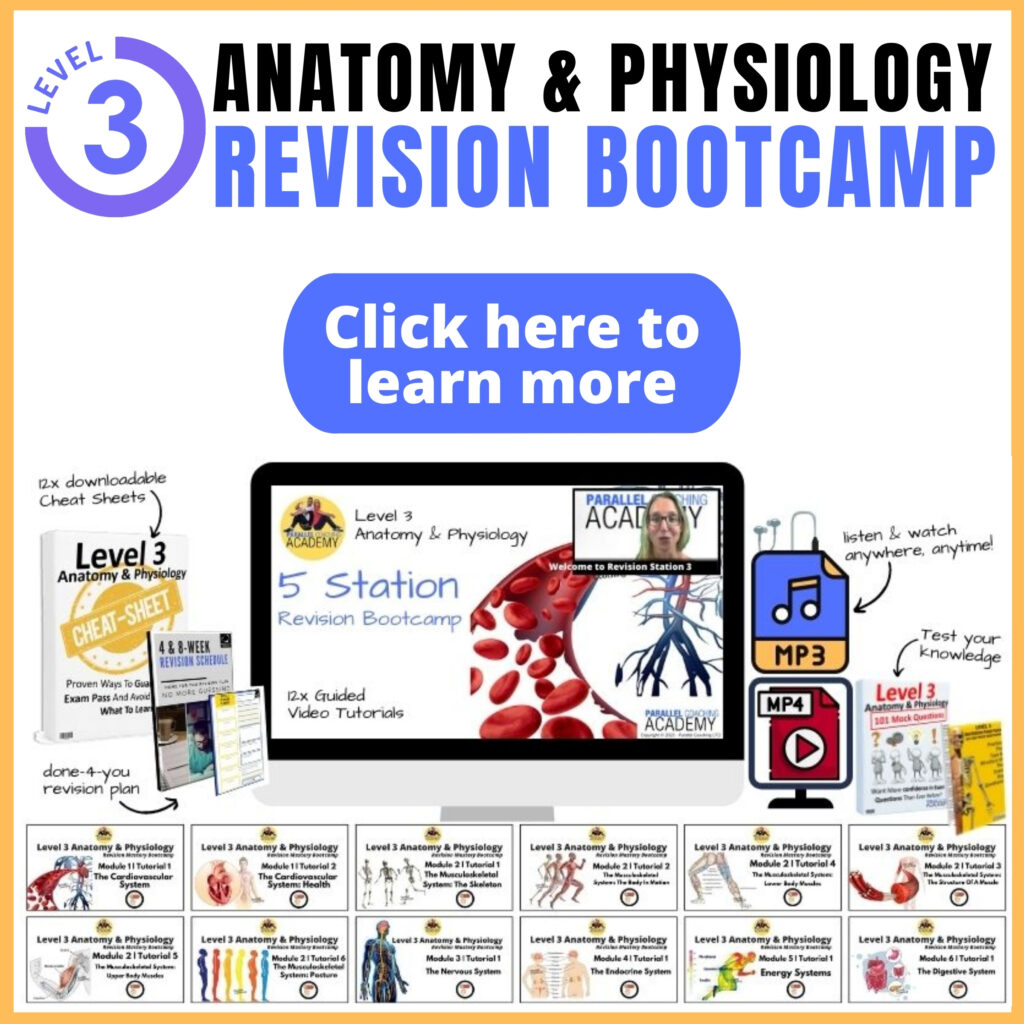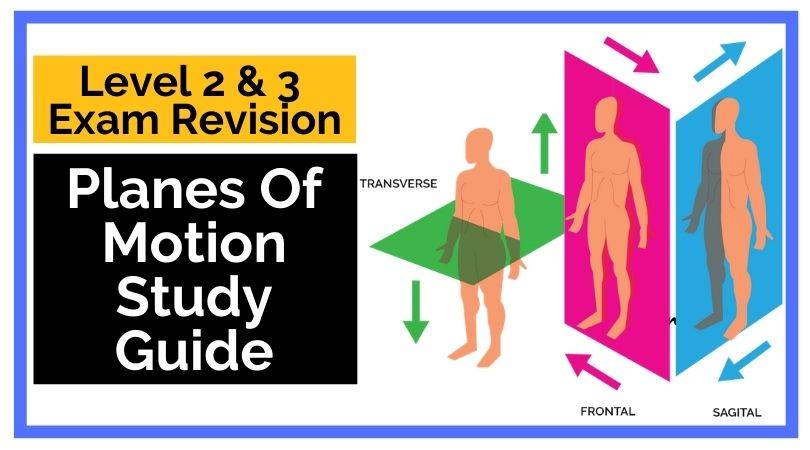This anatomy and physiology study guide will teach you everything you need to know about the three planes of motion for your Level 2 and 3 Anatomy exam.
You’ll discover:
- What are the three planes of motion?
- Anatomy and Physiology study guide to all three planes of motion
- Anatomy and Physiology Study Guide to Joint Actions
- Planes of Motion Mock Questions and answers to test your knowledge
What are the three planes of motion?
There are three planes of motion in which we move. If you think about it, most of our movements are not straight up and down, or side to side etc, especially in sports, they tend to combine a mixture of movements in different planes.
However planes of motion talks about the movement at ONE joint at a time.
Think of a plane of motion as a dimension – we move in three dimensions making us 3D
| Joint action | How to remember | Examples | |
| Sagittal | Flexion + Extension | Easiest to see movement from the Side | Walking
Squatting Lunging |
| Frontal | Abduction, Adduction, Lateral Flexion & Extension, Elevation & Depression Eversion and Inversion | Easiest to see movement from the Front | Shoulder press
Side Lunge Hip Abduction |
| Transverse | Rotation, Pronation, Supination, Retraction, Protraction, Horizontal Flexion & Extension | Easiest to see movement from the Top and Twisting | Spinal rotation
Pec Fly Rear fly |
Anatomy and Physiology Study Guide – Planes of Motion
Sagittal Plane
The Sagittal plane passes through the body front to back, so dividing it into left and right. Its like having a pane of glass to the left and right of you allowing you to move only forward or up and down, not side to side or twisting.
Movements in this plane are the forward and backward movements of flexion and extension. Most activities in daily live fit within the Sagittal plane – including walking and sitting.
Frontal Plane
The frontal plane divides the body into front and back. Movements in this plane are sideways movements and are as if you have a pane of glass in front and behind you, restricting any forward or twisting motion.
Transverse Plane
This plane divides the body into top and bottom. Movements in this plane are rotational in nature, such as internal and external rotation, pronation and supination
Anatomical Neutral
This is the starting position for describing any movement. It is important that you know this to be able to understand what is meant by certain movement patterns.
It is sometimes also called the anatomical starting position or fundamental starting position. In Anatomical-neutral every joint is in extension. At Parallel Coaching we call this he 5 Pillars:
Anatomical neutral is:
- Standing upright
- Legs together and knee straight
- Toes pointing straight forwards
- Arms by the side
- Palms facing forwards
Anatomy and Physiology Study Guide to Joint Actions
Flexion and Extension
Flexion is a movement in the sagittal plane, which decreases the angle at the moving joint. Extension is the opposite movement, which increases the angle at the joint. Many types of synovial joint are capable of flexion and extension (hinge; ball and socket; saddle; condyloid) including the shoulder, elbow, wrist, hip and knee. Here are some examples:
Shoulder flexion is the action of raising the arm above the head. The extension is then the downward movement.
Flexion and extension at the ankle joint is called dorsiflexion and plantarflexion. Dorsiflexion is when you point your toes towards the ceiling and plantarflexion is when you point your toes away, toward the floor. Remember to start in the anatomical starting position!
Horizontal Flexion and Extension
These are movements in the Transverse Plane, and are commonly understood from looking at shoulder movement during a pec fly motion. Horizontal Flexion of the shoulder can be best understood by standing in an Anatomical Neutral position and then bringing your hands together in front of the chest (moving only at the shoulder).
Horizontal Extension of the shoulder would be the process of opening the arms back out towards the sides of the body. Therefore creating a pec-fly style movement.
Abduction and Adduction
These are movements in the frontal plane and involve moving the body part away or towards an imaginary centre line. Abduction is taking the body part away from the central line and adduction is moving it towards (remember this by thinking adduction adds the body part to the centre). Adduction can also be moving the body part across the centre line and to the other side of the body, shown in the hip abduction video below. Amongst the joints capable of abduction and adduction are the shoulder and hip.
Other abduction and adduction movements include the fingers. If you splay your fingers and move them apart, this is abduction as they are moving away from the centre position. When you bring the fingers back together, this is adduction, as you are adding them back to the centre line.
Rotation
Rotation movements are in the transverse plane and include any twisting motion. Joints which permit rotation include the shoulder and hip. These are both ball and socket joints. We can also rotate our necks and backs due to a series of smaller joints, including the atlanto-axial joint which is a pivot joint in the neck between the first two vertebrae (C1 and C2).
Rotation of the hip and shoulder can be broken down into internal or external rotation (also sometimes known as medial and lateral rotation respectively). In the example of the shoulder video below, internal rotation is the movement of the hand either inwards towards the body (when the shoulder is adducted) or down to point towards the floor (when the shoulder is abducted). External rotation is therefore the opposite, when the hand moves away from the body (when the shoulder is adducted) or up towards the ceiling (when the shoulder is abducted).
Circumduction
Circumduction is a combination of all of the movements above. It is possible at ball and socket, condyloid and saddle joints such as the shoulder, hip, wrist and ankle. It involves moving the entire connecting limb through its full range of motion.
Pronation, Supination, Inversion and Eversion
Pronation and supination are specialised movements of the forearm and ankle. In the forearm, pronation is the movement of turning the palm over to face downwards (or backwards if starting in anatomical neutral). Supination is the opposite movement, of turning the palm up or forwards. The movement here comes from the proximal radio-ulnar joint (the joint just below the elbow, between the Radius and Ulna bones) which is a pivot joint, allowing the Radius to move around the Ulna.
At the ankle, supination is the movement of turning the sole of the foot inwards. This is sometimes called inversion. Pronation is the movement of turning the sole of the foot outwards, sometimes called eversion.
You will sometimes hear people saying they have over-pronated feet, meaning their sole turns outwards slightly more than it should when they walk or run, giving the appearance of a flat foot, without an arch.
In summary
- There are three planes of motions
- Each plane of motion relates to specific joint actions
- You can remember the planes of motion based on where you see the most movement
- Check out the three Planes of Motion Mock Questions Below to check your knowledge
- Here’s what Lydia had to say about the A&P Revision Bootcamp
I can’t recommend Parallel Coaching enough their learning material is fantastic and definitely was a huge factor in me passing my A&P level 3!
Lydia
Test your knowledge with these Planes of Motion Mock Questions
Now you’ve read the anatomy and physiology study guide for planes of motion – Look at the three Mock Questions below and jot down your answer on a scrap paper or as a note on your phone.
Then scroll down to reveal the answers.
Q1. Which movement occurs in only the sagittal plane?
A. Horizontal Flexion
B. Flexion
C. Lateral Flexion
D. Rotation
Q2. Which plane of motion does pronation of the foot occur?
A. Frontal
B. Sideways
C. Transverse
D. Sagittal
Q3. Which exercise occurs predominantly in the frontal plane?
A. Squat
B. Chest Press
C. Frontal Raise
D. Lateral Raise
Answers:
Q1: = B
Q2: = C
Q3: = D
Download Hundreds of Mock Questions For Free
If you want more mock questions like this, then you can download more Free Mock Questions: DOWNLOAD NOW
Need More Help with your Level 3 Anatomy Revision?
or Trainee FITPROS Taking Their L3 Anatomy & Physiology Exam.
Learn, Revise & Pass Your Level 3 Anatomy & Physiology Exam In Under 10-hours
(Without Having To Spend Hours Revising Or Feeling Overwhelmed)
If you want to get your revision structured, learn everything you need to know and feel confident on exam day, then click the link below:

Dedicated to More
Hayley “anatomy and physiology study guide” Bergman
Parallel Coaching
P.S. You can also find us on the following platforms:
Instagram: Follow Now
Facebook: Like Our Page
Twitter: Tweet Us
YouTube: Subscribe Here
More Planes and Axis blogs HERE

